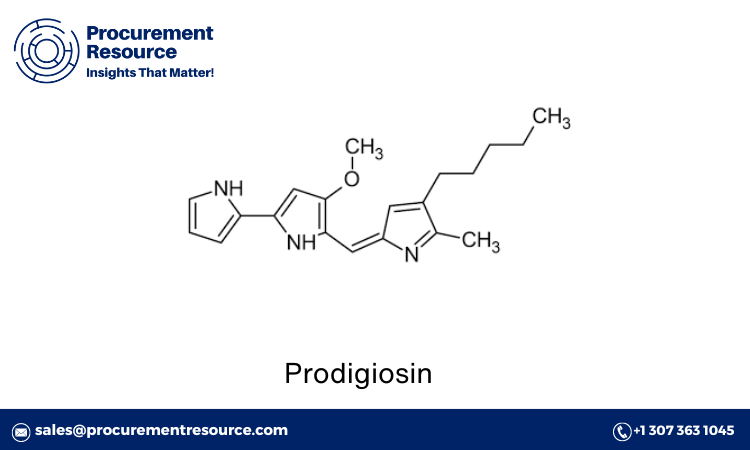Prodigiosin is a red pigment produced by certain strains of bacteria, notably Serratia marcescens. This compound has garnered significant interest due to its potential applications in pharmaceuticals, cosmetics, and as a natural dye. Understanding the cost of production is crucial for companies looking to invest in prodigiosin manufacturing. This report delves into the various aspects of prodigiosin production cost, including the production process, manufacturing report, raw material costs, and the latest news in the field.
Production Process
The production of prodigiosin involves microbial fermentation, where specific bacterial strains are cultivated under controlled conditions to produce the pigment. The process can be broken down into several key steps:
Request For Sample: https://www.procurementresource.com/production-cost-report-store/prodigiosin/request-sample
- Strain Selection and Cultivation: The first step involves selecting a high-yield strain of Serratia marcescens or other prodigiosin-producing bacteria. These strains are then cultivated in a suitable growth medium.
- Fermentation: The bacteria are incubated in a fermentation vessel with a nutrient-rich medium. Factors such as temperature, pH, and aeration are carefully controlled to optimize prodigiosin production.
- Extraction: Once the fermentation process is complete, the bacterial cells are harvested. Prodigiosin is extracted from the cells using organic solvents such as methanol or acetone.
- Purification: The extracted prodigiosin is then purified using techniques such as chromatography to remove impurities and achieve the desired level of purity.
- Drying and Formulation: The purified prodigiosin is dried and formulated into the desired end product, whether it be for pharmaceutical use, as a dye, or in cosmetics.
Manufacturing Report and Process
The manufacturing process of prodigiosin on an industrial scale involves scaling up the aforementioned steps while maintaining cost-effectiveness and ensuring quality control. Here is a detailed manufacturing report and process outline:
- Pilot Scale Testing: Before full-scale production, pilot-scale testing is conducted to optimize the fermentation conditions and extraction methods. This step is crucial to identify potential issues and refine the process.
- Large-Scale Fermentation: Industrial-scale fermenters, often with capacities ranging from hundreds to thousands of liters, are used. The growth medium is prepared in large quantities, and the bacterial culture is inoculated into the fermenters.
- Monitoring and Control: Advanced monitoring systems are employed to continuously track parameters such as temperature, pH, dissolved oxygen, and bacterial growth rate. Automated control systems adjust these parameters to maintain optimal conditions.
- Harvesting and Extraction: After a predetermined fermentation period, the bacterial biomass is harvested using centrifugation or filtration. The biomass is then subjected to solvent extraction to isolate prodigiosin.
- Purification and Quality Control: The crude extract undergoes purification processes, typically involving multiple stages of chromatography. Each batch is rigorously tested for purity, potency, and absence of contaminants.
- Final Product Formulation: The purified prodigiosin is formulated into various product forms as required by the market. This may involve mixing with excipients, encapsulation, or other formulation techniques.
Raw Material Costs
The cost of raw materials is a significant component of the overall production cost of prodigiosin. The primary raw materials include:
- Growth Medium Components: The nutrient medium for bacterial growth typically contains sources of carbon (e.g., glucose), nitrogen (e.g., peptone, yeast extract), and essential minerals. The cost of these components can vary based on their purity and source.
- Bacterial Strains: High-yield prodigiosin-producing strains may be purchased from culture collections or developed in-house. The cost of acquiring and maintaining these strains can add to the production cost.
- Solvents for Extraction: Organic solvents such as methanol, acetone, or ethanol are used for prodigiosin extraction. The cost of these solvents depends on market prices and purity requirements.
- Purification Reagents: Chromatography resins, filtration membranes, and other purification materials represent another cost factor. These reagents are often specific to the purification method employed and can be expensive.
- Utilities and Consumables: The cost of utilities (electricity, water, etc.) and consumables (e.g., filters, culture flasks) must also be considered. These costs can fluctuate based on production scale and location.
By optimizing the use of these raw materials and adopting cost-saving measures, manufacturers can reduce the overall production cost of prodigiosin.
Latest News
The field of prodigiosin production is continually evolving, with ongoing research and developments aimed at improving yield, reducing costs, and expanding applications. Here are some of the latest news highlights:
- Advances in Strain Engineering: Recent studies have focused on genetically modifying bacterial strains to enhance prodigiosin production. These engineered strains can potentially produce higher yields at lower costs, making the process more economically viable.
- Green Production Methods: Efforts are being made to develop environmentally friendly production methods that reduce the use of hazardous solvents and minimize waste. For instance, researchers are exploring aqueous-based extraction techniques and renewable feedstocks for fermentation.
- Expanded Applications: The applications of prodigiosin are expanding beyond traditional uses. New research has highlighted its potential as an anticancer agent, antimicrobial compound, and antioxidant. These findings could open up new markets and increase demand.
- Collaborations and Investments: Several biotechnology companies and research institutions are collaborating to commercialize prodigiosin production. Investments in research and infrastructure are driving innovations and bringing new products to market.
- Regulatory Approvals: As prodigiosin finds applications in pharmaceuticals and cosmetics, regulatory approvals play a crucial role. Recent approvals and certifications by regulatory bodies are paving the way for broader commercialization and consumer acceptance.
In conclusion, the production cost of prodigiosin is influenced by various factors, including the production process, raw material costs, and technological advancements. By staying abreast of the latest developments and adopting innovative approaches, manufacturers can optimize production and capitalize on the growing demand for this versatile compound.
